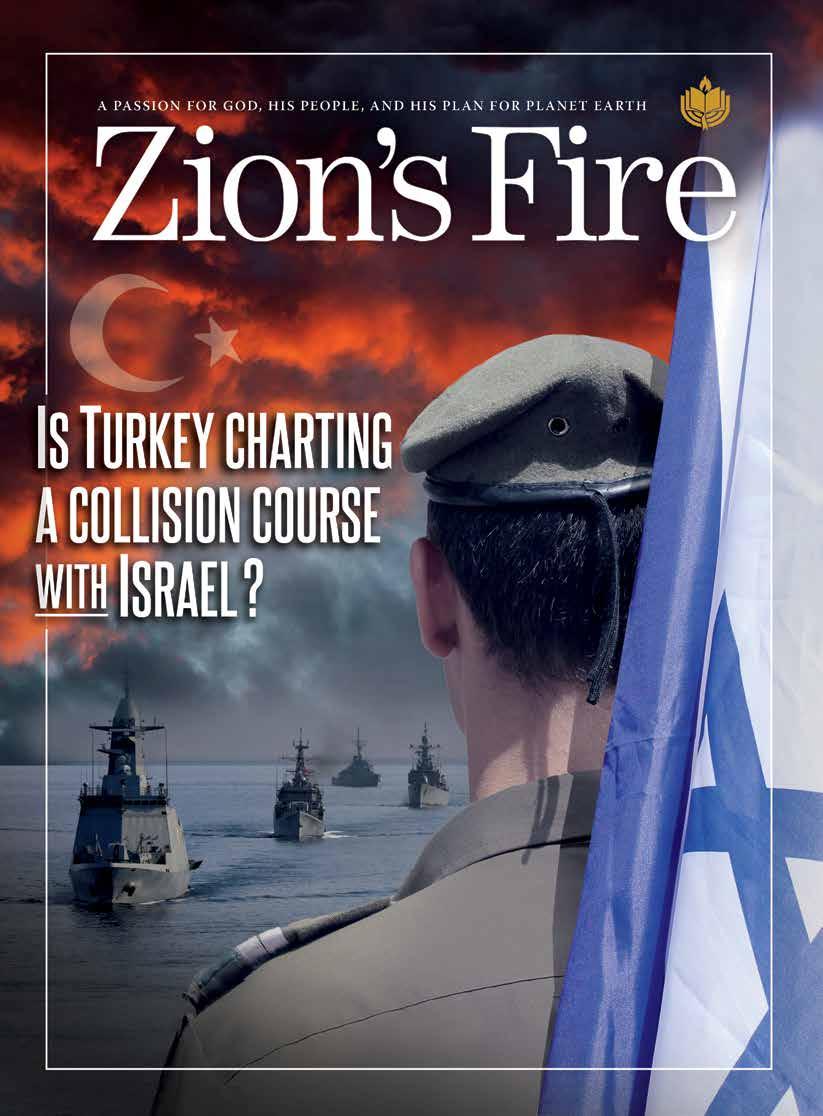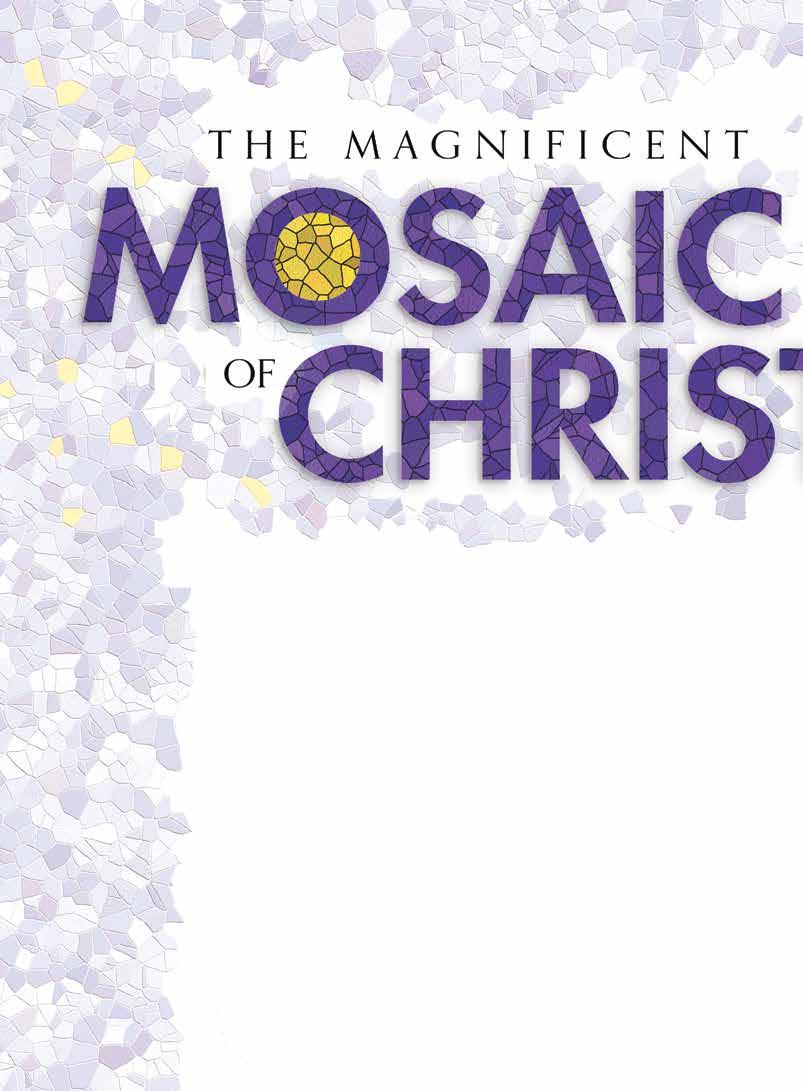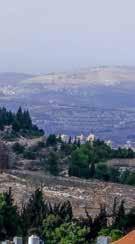Galatians: Grace & Peace
From God the Father and From Our Lord Jesus Christ

The Magnificent Mosaic of Christ
Sign
latest from Zion’s Hope at www.zionshope.org



Zion’s Fire Magazine
Zion’s Fire is a publication of Zion’s Hope.
© Copyright 2021 by Zion’s Hope, Inc., P.O. Box 783369 Winter Garden, FL 34778-3369
Production staff
Editor-in-Chief: Marvin J. Rosenthal
Managing Editor: David Rosenthal
Graphic Design: Catherine LeMand
Michael Feland
Cheryl Philips
Copy Editors: Marbeth Rosenthal
Michael Ufferman
David Ettinger
Typist: Marbeth Rosenthal


M Ay -June 2021
fLashPOint Is Turkey Charting a Collision Course With Israel?
David Rosenthal
Much of Israel’s focus is on Iran, but another threat looms large. Turkey’s radical Islamist leader, President Recep Erdogan, is arguably Israel’s loudest critic and most powerful antagonist.
insight feature
5 Galatians: Grace & Peace From God the Father and From Our Lord Jesus Christ
Marv Rosenthal
Paul never writes, “Peace and grace.” There can never be true peace without the grace of God which leads to salvation. Grace is the basis for peace.



Subscriptions
insight feature
Properly Understanding, “A Thief in the Night”
David Ettinger
Too many believers cite this phrase as proof that Jesus Christ can return at any time. However, upon closer examination, Scripture simply doesn’t support this notion.
insight feature
The Magnificent Mosaic of Christ
Dan Hayden
Marvelously designed by God, the 66 books of the Bible blend together as a 66-piece mosaic of the Man – Jesus Christ – who is the Word.
MissiOn rePOrt
Samarian Roadtrip
Josh in Jerusalem
The Lord richly blessed our missionary outreach as we shared the Gospel with three Jewish men, three Muslim men, and distributed multiple Bibles.
Our Purpose and Passion
A one-year subscription is $20. A two-year subscription is $30. Add $10 per year for foreign subscriptions. 407-654-ZION (9466) • 1-888-781-ZION (9466)
Identification
Zion’s Fire (ISSN 1052-2301, USPS 005423) is published bimonthly by Zion’s Hope, Inc., 146 West Plant Street, Suite 300, Winter Garden, FL 34787-3136. Periodicals postage paid at Winter Garden, FL and additional mailing offices.
POSTMASTER: Send address changes to: Zion’s Hope, Inc., P.O. Box 783369 Winter Garden, FL 34778-3369
Printed in the USA by Print By Design, Inc. All photos, unless otherwise noted, are © by Shutterstock.com
Zion’s Hope is a Bible-based ministry whose purpose is to proclaim to Jewish and Gentile people throughout the world their need for personal salvation through Jesus, the Messiah of Israel. We’re also committed to helping Christians grow in their understanding of biblical prophecy and the importance of Israel in God’s plan for the Last Days. To that end, we teach Scripture in its historical, geographical, and cultural context to prepare God’s people for end-time events and the return of Jesus Christ.
Giving
Your generous support for the ministry of Zion’s Hope is greatly appreciated. All donations will generate a tax-deductible receipt.
2 Zion’s fire | MAy-June 2021 TABL e of C on T en T s V o L. 32, no .3
3 22 12 14
receive the
Updates and Email Letters
SUBSCRIPTION
up to
Ministry
EMAIL
Is Turkey Charting a Collision Course With Israel?
By supporting the Palestinians in Gaza and condemning Israel, Turkish President Recep Erdogan intends to expand Turkey’s footprint in the Middle East and the Mediterranean Sea.
Israel’s dramatic government shake-up garnered global attention last month as Benjamin Netanyahu, Israel’s nowformer Prime Minister, was ousted by rival political factions by a razor-thin margin. A new government has taken power – at least for the time being – led by Naftali Bennett, who heads a right-wing party in Israel, and Yair Lapid, leader of a center-left party. These two men successfully cobbled together a diverse coalition that includes several smaller parties that have little in common. Together, they were able to form a bloc and amass enough seats in Israel’s parliament to topple Netanyahu, who led Israel for the past 12 years.
Shockingly, this new government coalition is comprised of a pro-Israel right-wing party, a left-wing labor party, a far-left secular party, and an Arab party with strong connections to the Muslim Brotherhood. In this power-sharing alliance, Bennett will serve as Prime Minister for two years, followed by Lapid for an additional two years. However, it remains to be seen whether this new coalition will be stable enough to govern, or will instead be plagued by infighting due to strong ideological differences.
This political earthquake is only the latest in a series of vexing issues Israelis have faced in the past two years. They’ve seen their Prime Minister indicted on charges of corruption. They’ve gone through four contentious national elections. They’ve endured some of the most restrictive coronavirus lockdowns in the world. And most recently, they were forced to defend themselves against the aggressions of the terror group Hamas, which fired more than 4,000 mortar shells and rockets at Israeli cities and towns.
Even more distressing to many living in Israel is the knowledge that Iran continues its obsessive campaign to develop nuclear
weapons – which its radical leaders have threatened time and again to use against Israel. According to many military experts, it is no longer a question of how many years it will take Iran to achieve its goal – it is now a question of how many months.
Much of the focus in the Middle East centers on Iran and its terrorist proxies, Hamas and Hezbollah. But another threat looms large to Israel’s north. As I have written in previous Flashpoint Reports, I believe Turkey will play a significant military role in the events of the Last Days based on prophetic texts such as Ezekiel 38 & 39, and Daniel 11.
The radical Islamist leader of Turkey, President Recep Erdogan, has arguably become Israel’s loudest critic and most powerful antagonist. His rhetoric is vitriolic, and his actions are dictatorial.
Unquestionably, his desire is to bolster Turkey’s power and influence and expand its geographic footprint across the Middle East and Mediterranean Sea.
Through state-run Turkish media, which is the propaganda mouthpiece of Erdogan’s ruling government, several of Turkey’s key military leaders have espoused a doctrine known as Mavi Vatan, which means “Blue Homeland.” Essentially, this doctrine completely disregards internationally accepted maritime standards and redefines undersea borders for Turkey’s own benefit. By redrawing maritime maps, Turkey has arbitrarily awarded itself legal control of the natural resources within all the waters surrounding its vast coastline –ignoring a myriad of Greek Islands scattered throughout the Aegean and Mediterranean Seas.
“Blue Homeland” is the name of Turkey’s new maritime strategy. But it is also the name of the official journal sponsored by the Turkish Naval War College, and the name used for a large Turkish naval

Daniel 11:40-42
And at the time of the end shall the king of the south [likely the leader of Egypt] push at him [the Antichrist, who is likely the leader of Turkey]: and the king of the north [from Turkey] shall come against him [in Egypt] like a whirlwind, with chariots, and with horsemen, and with many ships; and he [the Antichrist] shall enter into the countries, and shall overflow and pass over.
He [the Antichrist] shall enter also into the glorious land [Israel], and many countries shall be overthrown: but these shall escape out of his hand, even Edom, and Moab [Jordan], and the chief of the children of Ammon [King of Jordan].
He shall stretch forth his hand also upon the countries: and the land of Egypt shall not escape.
3 GEOPROPHECY REPORT FLASHPOINT ZION’S FIRE | MAY-JUNE 2021
Mavi Vatan
Through its Blue Homeland doctrine Turkey claims control of 462,000 square kilometers of sea.
exercise held in 2019. The now-pervasive use of the term Mavi Vatan in Turkish society makes it clear that President Erdogan and his government are intent on implementing their neo-Ottoman expansionist strategy – not only on land, but also by sea.
Black Sea
Caspian Sea
TURKEY’S MAVI VATAN (BLUE HOMELAND)
Preferred EastMed Pipeline route from Israel’s natural gas fields to Europe
Alternate EastMed Pipeline route from Israel’s natural gas fields to Europe
Turkey & Libya’s shared maritime zone. The 2019 agreement was designed to block the EastMed Pipeline
Turkey’s proposed shared maritime zone with Gaza intends to block the EastMed Pipeline
Mediterranean Sea
Erdogan’s vision of Turkish expansion in the eastern Mediterranean is directly linked to his desire to capture and control natural resources – specifically, the major natural gas deposits discovered in the territorial coastal waters of Greek Cyprus, Israel, and Egypt. These three countries have an agreement to run a natural gas pipeline under the Mediterranean Sea toward the Greek mainland and on to Italy and the rest of Europe. Each of them stands to reap a windfall if the EastMed Pipeline becomes a reality. Turkey, which is not part of the deal, is doing all it can to force the others to include Turkey in their newly established EastMed Gas Forum, or to prevent the pipeline initiative from ever becoming a reality.
Red Sea
Turkey would give support, weaponry, and mercenaries to fight in Libya’s domestic war in exchange for Libya granting Turkey unfettered access and control of Libyan coastal waters through a sea corridor in the Mediterranean. This agreement, where Turkey and Libya arbitrarily claimed territorial control of a swath of the Mediterranean that spanned the entire sea from Turkey to north Africa, was then touted by President Erdogan as a legitimate means for Turkey to block the EastMed pipeline from reaching Europe apart from Turkish consent.
During the recent conflict between Hamas and Israel, Turkey loudly condemned Israel in support of the Palestinians and Hamas terrorists in Gaza. President Erdogan publicly called for an “International Protection Force” to enter the conflict and “give Israel a strong and deterrent lesson.” He also pressed for the UN Security Council to rapidly intervene with “determined and clear messages” for Israel.
And now Erdogan, who is a staunch proponent of the radical Muslim Brotherhood, is taking his grand expansionist plans a step further by threatening another “sea grab” similar to the one with Libya in 2019. Only this time, he is threatening to sign an agreement with the Palestinians, who are ruled by Hamas terrorists in Gaza.
The narrow sea corridor that would be created between Turkish waters and the coast of Gaza is contiguous with Israel’s Mediterranean coast and only a short distance from Israel’s largest population centers. In the words of a recent Jerusalem Post article, “this would put Israel and Turkey on a military collision course.”
In 2019, Turkey attempted to block the pipeline through an agreement it forced upon an embattled Libyan government under duress. The agreement stipulated that
In short, Turkey is attempting to utilize its close relationship with Hamas and its support for the Palestinians in Gaza to gain the upper hand in the race to control the flow of natural gas in the eastern Mediterranean. Even more, by facilitating a toxic environment in Gaza between the Palestinians and Israel, Turkey hopes to establish a beachhead in Gaza (under the guise of a peacekeeping force) for its own political aspirations – all with an eye toward the ultimate prize – Jerusalem. u
4 ZION’S FIRE | MAY-JUNE 2021 GEOPROPHECY REPORT FLASHPOINT
2 2 2 2 1 1 1 1
SAUDI ARABIA
L I BYA
EGYPT
SUDAN
IRAN
IRAQ
SYRIA
JORDAN
LEBANON
ISRAEL GAZA
CRETE CYPRUS
GREECE
QATAR
KUWAIT
YEMEN
ERITREA
DJIBOUTI SOMALIA
ETHIOPIA
Gulf of Aden Persian Gulf
1 2

The Apostleship of Paul
The epistle to the Galatians opens with three crucial words: “Paul, an apostle.” To fully comprehend the importance of this phrase we need to look at another of Paul’s letters – specifically Romans Chapter 1, where we read: “Paul, a servant of Jesus Christ, called to be an apostle, separated unto the gospel of God” (v. 1). Note the two points Paul is emphasizing: 1) that he is a servant of Christ; and 2) that he was called to be an Apostle. In the King James Version, the words “to be” are italicized. Whenever you see italicized words in the Bible, it is an indication from the English translators that the italicized words were not part of the original Greek text, but were inserted there to make the English read more logically. Though well-intended, sometimes this can unintentionally conceal the primary emphasis of the text.
I believe this is the situation in Romans 1:1. The KJV wording “called to be” is misleading. It is misleading because the meaning of the text is not that Paul was called “to be” an Apostle – as if it were some kind of progressive procedure – but that he was a “called” Apostle. It was not a matter of “process” or “becoming”; instead, it was an instantaneous appointment. God called Paul an Apostle; it’s as simple as that.
The word “apostle” carries with it two basic ideas. First, being an Apostle meant being called to God. Second, the Apostle was sent by God. Therefore, the “job description” of an Apostle was that he was called to God, and sent by God.
The concept of apostleship was extremely important. Keep in mind that at the time Paul was writing his letters, there was no New Testament. It may have been in the process of becoming the New Testament,
The word “apostle” carries with it two basic ideas. First, being an Apostle meant being called to God. Second, the Apostle was sent by God.
 Written by Marvin J. Rosenthal
Written by Marvin J. Rosenthal
5 ZION’S FIRE | MAY-JUNE 2021 GALATIANS PART 2: GRACE & PEACE
but in Paul’s day the epistles had not yet been gathered, organized, and placed into one volume from which believers could read and learn. For this reason, the sources of authority in the early Church were the Apostles who had lived with Christ during His earthly ministry. They witnessed His miracles, heard His messages, and worked side by side with Him. When the Lord returned to the right hand of the Father in Heaven, the Apostles were left on Earth to proclaim to the world what they saw and what they knew to be truth. It was their job to avow the things Jesus did and taught. For this reason, apostolic authority was crucial. To be an Apostle was the height of authority in the early Church. Due to the small number of Apostles and the authority they held, believers listened very carefully to what they said and taught.
By the time Paul penned his letter to the Galatians, he had already built an impressive résumé. He had received the backing of the Church leaders in Jerusalem and been declared by them as an Apostle. However, not all believers knew this. Therefore, when Paul wrote he was an Apostle, he was not boasting. Instead, he was making clear to his readers that he had been called to a unique relationship with God, and he was being sent out by God, with God’s full authority. Paul had been sent out with not only the message of God, but with the authority of the One who sent him. Therefore, when Paul claimed apostleship, he did so to give weight to the things he was teaching.
In 1 Corinthians 1:1, we read: “Paul, called to be an apostle of Jesus Christ through the will of God.” Notice that when Paul refers to his apostleship, it is to Jesus
To be an Apostle was the height of authority in the early Church. Due to the small number of Apostles and the authority they held, believers listened very carefully to what they said and taught.
When Paul refers to his apostleship, it is to Jesus Christ, not to some teacher or religious leader.
With such importance placed on apostleship, it was of concern to some that Paul was not one of the original Twelve. He was not personally trained by Christ during His earthly ministry, but encountered Christ following the Lord’s resurrection. However, because he was not one of the original Twelve, his apostleship was questioned, and Paul had to deal with this issue in his letter to the Galatians. He had to convince his readers that he saw Christ and was trained by Him as were the other Apostles, but not at the same time. This being the case, what Paul said and taught was just as authoritative as what the original Apostles said and taught.
Christ, not to some teacher or religious leader. In other words, Paul has been called and sent by deity. Notice, also, Paul’s words, “through the will of God”; it is as if Paul is saying, “I didn’t choose this for myself. I didn’t ask for this. I didn’t politic for this. The fact is, this is the will of God. I am an Apostle because God has chosen me to be one. If you don’t like it, or if you think I don’t have the necessary qualifications – talk to God. This is His doing, not mine.”
Paul makes the same point in 2 Corinthians 1:1: “Paul, an apostle of Jesus Christ by the will of God.” We see the same thing in Ephesians 1:1: “Paul, an apostle of Jesus Christ by the will of God.” Notice how

6 ZION’S FIRE | MAY-JUNE 2021 INSIGHT FEATURE
Paul underscores his apostolic authority. He does the same thing in Colossians 1:1: “Paul, an apostle of Jesus Christ by the will of God.” The point is clear: Paul is an Apostle, called by God, and his authority is absolute. What he teaches is God’s Word.
The Peace of God
After introducing himself to the Galatians as an Apostle, Paul writes: “And all the brethren which are with me, unto the churches of Galatia: Grace be to you and peace from God the Father, and from our Lord Jesus Christ” (Galatians 1:2-3). In all of Paul’s letters you will read the phrase, “Grace be to you and peace …” This is not just a friendly greeting; rather it is of paramount truth. It is never the other way around. You will never read where Paul writes, “Peace and grace.” There can never be peace – true peace – without the grace of God which leads to salvation. Grace is the instrument, or basis, for peace.
... Through Christ, there is
This peace Paul refers to is peace with God. In its natural state, the human race is at enmity with God; we are His innate enemies; it is ingrained in us. Humanity has turned its back on God. Humanity has rebelled against God and is therefore under God’s judgment. Unsaved humanity is heading for the Day of the Lord wrath and the Great White Throne Judgment (Revelation 20). Because of this, there is no peace for humanity. However, through Christ, there is peace. For all those who surrender to the lordship of Jesus Christ, there is trading in death for life, punishment for forgiveness, and wrath for peace.
The Greek word for “peace” Paul uses here can be translated “the ending of hostilities.” And more than that, the hostilities are replaced by a warm and loving relationship with God the Father, Jesus Christ the Son, and the Holy Spirit Intercessor. It is not only that we are no longer enemies, but there is in its place a brand new endearment. In
Grace be to you and PEACE FROM GOD THE FATHER, and from our Lord Jesus Christ.
– Galatians 1:3
.
For all those who surrender to the lordship of Jesus Christ, there is trading in death for life, punishment for forgiveness, and wrath for peace.

7 ZION’S FIRE | MAY-JUNE 2021 GALATIANS PART 2: GRACE & PEACE
In the world’s peace, the positive ingredient is missing; in God’s peace, the positive ingredient is part of the package.
No one is moral. No one by human nature is deserving of God’s favor.
IT IS ONLY THROUGH GRACE THAT TRUE PEACE CAN BE ATTAINED.
our world, the signing of a peace accord usually translates into a cessation of war, which is good, but that which should be the by-product of peace – mutual respect, looking out for one another’s welfare, sharing of technology which can improve the quality of life – is too often missing. However, when Paul writes of peace, he is talking about the cessation of hostility as well as the wonderful by-products that can come from peace with God. In the world’s peace, the positive ingredient is missing; in God’s peace, the positive ingredient is part of the package.
What is it that brings about this wonderful peace between redeemed humanity and a holy God? The answer is simple: God’s grace. If you ask an unbeliever if he believes in Heaven, he is likely to give a lukewarm “Yeah.” If you ask, “Do you think you will go to Heaven when you die?” he might say, “I believe so.” You may follow up with a question such as, “Upon what do you base this belief?” He will say, “Well, I’ve never killed anybody; I’ve never robbed anybody; and I have never beat up my children. Overall, I’m a pretty moral person and have lived a pretty moral life. I believe that qualifies me to go to Heaven.”
No one is moral. No one by human nature is deserving of God’s favor. If you believe you have done anything to gain God’s blessing, you have totally missed the point of Paul’s teaching. Paul wrote over and over again, “Grace be unto you, and peace.” It is only through grace that true peace – the only peace that counts – can be attained.
Is it any wonder Paul begins his epistle with such pointed and powerful words? His message could not be more clear and compelling: “I am Paul, an Apostle of God –appointed and commissioned by Jesus Christ Himself – and I am proclaiming to you the message of grace and its fruit, which is peace. Only by grace can this peace be had. Works can’t do it. The legalists are wrong. They have no authority to teach. They have no authority to tell you that you must unite the Mosaic Law with God’s grace to be made acceptable before God and attain His peace. No, no, no! It is through grace – and grace alone!”
This is why in verse 9 Paul writes, “If any man preach any other gospel unto you than that ye have received, let him be accursed.” This is not Paul being an ambassador or a diplomat. This is Paul, in the strongest possible language, denounc-
What is it that brings about this wonderful peace between redeemed humanity and a holy God? The answer is simple: God’s grace.

This is the typical thinking of the person who self-justifies based upon works. It is all about, “I do this,” or “I have never done that.” Paul’s entire point, however, is that this is not the way to Heaven. No one can gain acceptability before God based upon works. Outside of God, no one is good.
ing and condemning those who would corrupt the Gospel of grace, and calling for their divine judgment. Picture Paul as a boxer sitting in his corner eager for the bell to ring. He has but one thought: to knock out the opponent – which is the false teaching of “justification by the Law” (works).
8 ZION’S FIRE | MAY-JUNE 2021 INSIGHT FEATURE
A Willing Sacrifice
Paul continues in verse 4: “… Who [Jesus] gave himself for our sins, that he might deliver us from this present evil world, according to the will of God and our Father.” Please don’t read the first part with a passing glance and then move on. Read it again: “Who gave himself for our sins.” Jesus was different from us in many ways, one of which is He was born to die. By contrast, human beings are born to live.
What enters your mind when you read the phrase, “the Lamb slain from the foundation of the world” (Revelation 13:8)? What you should be thinking is that the death of Christ has always been in the plan, program, and purpose of God. It did not happen by chance. Christ’s coming to Earth to die for sinners was designed in the heavens before the creation of time. Jesus said:
For even the Son of man came not to be ministered unto, but to minister, and to give his life a ransom for many (Mark 10:45).
Jesus came to freely give His life. He expresses the same thought in John 10:18:
No man taketh it [my life] from me, but I lay it down of myself. I have power to lay it down, and I have power to take it again. This commandment have I received of my Father.
No one took Jesus’s life; not the Pharisees, not the false witnesses, not the Romans. Will they have to give an account to God for their wicked treatment of Christ during His earthly ministry? Of course they will. But Jesus is absolutely clear on the point that He willingly surrendered His life so many would receive salvation through
His shed blood. Concerning His death, Jesus said, “for this cause came I into the world” (John 18:37).
At Jesus’s arrest in the Garden of Gethsemane, Peter used his sword to lop off the ear of the high priest’s servant (Matthew 26:51). Jesus turned to His zealous disciple and said, “Thinkest thou that I cannot now pray to my Father, and he shall presently give me more than twelve legions of angels?” (v. 53). Jesus could have saved Himself at any time if He so chose. It is crucial to understand Jesus gave Himself for us. It wasn’t that things got out of control. It wasn’t that events occurred He did not anticipate. It wasn’t that He was powerless to intervene. No, Jesus came into the world for this very purpose; He came to die. Hence, Paul writes, “… who gave himself for our sins” (Galatians 1:4).
The question we now must ask is, “Why? Why did Jesus give up His life?” Paul’s reply is: “… that he might deliver us …”. Many Christians like to think we played a role in our own salvation. But this is entirely untrue. We can do nothing to deliver ourselves. Rather, it is Christ alone. And not only has He delivered us, but He has delivered us from “this present evil world [age].” Furthermore, Christ did not deliver us by His will alone, but “according to the will of God and our Father.” I hope you understand the age we are living in is evil. If you didn’t necessarily believe this 20 years ago, then you certainly must believe it now.
The truth is, this age has always been evil. There have been moments in history which have been better than others, but it has always been evil. The term “present age” refers to the time of Adam and Eve to the present. At His second coming the Lord will usher in a Golden Age (Isaiah 11; Revelation 21). That age is also referred to as the

Jesus came into the world for this very purpose; He came to die.

Many Christians like to think we played a role in our own salvation. But this is entirely untrue. We can do nothing to deliver ourselves. Rather, it is Christ alone.
9 ZION’S FIRE | MAY-JUNE 2021 GALATIANS PART 2: GRACE & PEACE

Certainly, there are temporal joys we can experience in this world ...
... but righteousness as a rule will never be realized here on Earth until Jesus returns to establish His Kingdom.
Kingdom Age, the Messianic Age, and the Millennium. During that future age, Jesus Himself will rule the earth with a rod of iron. At that time there will be a righteous King sitting upon the throne. He will preside over a righteous government, and there will be peace on the earth.
But for now, the age is evil. Governments are corrupt. Granted, some function better than others, but throughout recorded history, there has never been a righteous government. The sobering reality is that in this age we will never see the proverbial “end of the rainbow.” There is nothing of enduring goodness in this age. Certainly, there are temporal joys we can experience in this world, and there are wholesome pursuits and pleasures we enjoy for a season, but righteousness as a rule will never be realized here on Earth until Jesus returns to establish His Kingdom.
So what does Paul mean when he writes that we have been delivered from this present evil age? Our deliverance comes in two forms. The first is present: we have been delivered from the eternal punishment for sin and transported to the realm of
righteous age to come can be attained only through Christ, and Christ alone. There is not a single thing we can do on our own to get there; only the finished work of Christ on the cross, the work for which He willingly gave Himself, can deliver us.
Paul finishes his short but powerful introduction by writing: “To whom be glory for ever and ever. Amen” (v. 5). God, by nature, is a God of glory, and His glory will resound throughout the universe and beyond for all eternity.
A Heretical Gospel
However, no sooner does Paul finish his introduction than he launches into the primary issue concerning the Galatians: “I marvel that ye are so soon removed from him that called you into the grace of Christ unto another gospel” (v. 6).
When Paul says “I marvel,” you can read this as, “I am exasperated by you!” He “marvels,” not because he is pondering some puzzle with the desire to learn from it or solve it. No, Paul’s marveling is an expression of acute anger and frustration. As an Apostle, he is fighting for the doctrine of
Our deliverance comes in two forms. The first is present: we have been delivered from the eternal punishment for sin and transported to the realm of eternal life.
The second is future: In a very physical sense, we will bask in the reality of true righteousness for 1,000 years in the Kingdom Age, or Millennium.
The sobering reality is that in this age, we will never see the proverbial “end of the rainbow.” There is nothing of enduring goodness in this age.
eternal life. The second is future: In a very physical sense, we will bask in the reality of true righteousness for 1,000 years in the Kingdom Age, or Millennium. It will be an age of absolute righteousness; absolute power, and absolute wisdom. Jesus, in all His infinite attributes, will be sitting on the throne of David, ruling over the world. This deliverance from this evil age and into the

the grace of God and fighting against the teaching of those who are perverting this doctrine.
I can fully empathize with Paul. I can fully understand his acute anger and frustration. I am also angered when I hear non-biblical, heretical teaching being propounded in the name of Christ. Not only does this terrible teaching anger me, but I
10 ZION’S FIRE | MAY-JUNE 2021 INSIGHT FEATURE

also am exasperated by Bible-believing Christians who do not have the discernment to recognize false teaching when they hear it.
Such are Paul’s sentiments. He is stunned by the fact that the Galatians “are so soon removed” – the Greek more accurately reads, “that you have removed yourselves.” In other words, they willingly embraced the heresy of the false teachers. When Paul was with them, he taught them all about the grace of God. There was no misunderstanding his message. In fact, the Galatians accepted Paul’s teaching, and probably did so joyously. Yet, when these false teachers came spreading an alternate Gospel, which is no Gospel at all, the people, for some inexplicable reason, jumped on the works-plus-grace bandwagon and heartily accepted it.
In doing so, the Galatians were putting themselves back under the bondage of the Law. Paul was stunned … flabbergasted. Not only did they buy into the lie, but they did it “so soon removed from him that called you into the grace of Christ.” Heresy was preached. The Galatians had the choice to accept or reject it. They chose to accept it.
What about you? Are you living in the light of God’s grace?
And what they were accepting was “another gospel: Which is not another” (vv. 6-7). This alternate gospel of Law plus grace was not genuine.
Besides being angered, Paul is astonished the Galatians can “demote” themselves from the loftiness of grace and place themselves down in the cellar of Law. Paul marvels – in a negative way – at such a decision by the Galatians.
What about you? Are you living in the light of God’s grace? I sincerely hope and pray you will lay hold of the concept of the grace of God. A deeper understanding of God’s grace will give you a greater love for God as you more fully comprehend all He has done for you, a sinner deserving of judgment – but instead – blessed with God’s mercy and goodness. u

Look for “Galatians Part 3” in the next issue of Zion’s Fire. In this upcoming article, we’ll see that Paul assures the Galatians the Gospel he is preaching was not taught to him by any man. Rather, he was given the Gospel as direct revelation from the Lord Jesus.
 Written by Marvin J. Rosenthal
Written by Marvin J. Rosenthal
11 ZION’S FIRE | MAY-JUNE 2021 GALATIANS PART 2: GRACE & PEACE

‘‘ ‘‘
A Thief in the Night
The Biblical Timing of Christ’s Return
The Day of the Lord refers to a future time when Jesus will return as the Lion of Judah to purge Earth and pour out His wrath upon unbelievers.
Well-Meaning
In regard to the timing of Christ’s return, there are various opinions as to when that blessed moment will occur.
Though there are many differences of interpretation in connection to biblical prophecy, most conservative, evangelical Christian scholars understand there will be a unique 7-year period at the end of this era of human history. And though no one knows with absolute certainty how all the pieces will fit together sequentially, we understand this time will include the rise of the Antichrist, the persecution of Christians and Israel, cataclysmic events occurring upon Earth and in the sky, the resurrection of dead saints and rapture of the living Church, and a time of severe judgment.
It is, however, the timing of the Rapture of the Church which has been the source of significant controversy. Will the Rapture –the gathering of Christians to Christ at His coming (1 Thessalonians 4:17) – occur before the climactic 7-year period, at its end, or sometime during? Christians who hope to avoid going through this period
(which has been incorrectly labeled “The Tribulation” cite one verse in particular to defend what is commonly called the “Pretribulation Rapture” view.
The verse is 1 Thessalonians 5:2, which says, “For yourselves know perfectly that the day of the Lord so cometh as a thief in the night.” However, as we will soon see, many well-meaning believers have incorrectly interpreted this verse.
The Misinterpretation
The Day of the Lord refers to a future time when Jesus will return as the Lion of Judah to purge Earth and pour out His wrath upon unbelievers. Immediately prior to this time of divine judgment, Jesus will rapture the Church. Pretribulation Rapturists believe this will occur before the 7-year period, based on their interpretation of 1 Thessalonians 5:2. The idea is that a “thief in the night” comes at a time when the occupants of a home are not expecting him. They are totally unaware something astonishing is about to occur. Christians who hold this view believe the Lord will return to
12 ZION’S FIRE | MAY-JUNE 2021 INSIGHT FEATURE
PROPERLY UNDERSTANDING
Earth at any time – that is, without notice or warning – and without any prophesied events occurring prior to the Rapture. This pillar of Pretribulationism is known as “imminence,” but it cannot be defended from Scripture.
Look closer at the full context of 1 Thessalonians 5:2. Yes, Jesus “cometh as a thief in the night,” but for whom? Verse 3 says: “For when they shall say, Peace and safety; then sudden destruction cometh upon them, as travail upon a woman with child; and they shall not escape.” This doesn’t sound like the Rapture of believers, does it? After all, later in verse 9, Paul explains, “For God hath not appointed us to wrath, but to obtain salvation by our Lord Jesus Christ.” But verse 3 indicates Jesus will bring His wrath with Him.
The crucial point is this: Jesus IS coming as a “thief in the night” for the unsaved!
Verse 4 continues: “But ye, brethren, are not in darkness, that that day should overtake you as a thief.” Aha! This verse is addressed to “brethren” – believers. It is unbelievers who are living “in darkness” and will be caught off-guard. Believers, however, are not in the dark, as verse 5 affirms: “Ye are all the children of light.”
So yes, the Lord will come like “a thief in the night,” but He will come this way for unbelievers, those who have no idea what is coming upon the earth. Believers, on the other hand, will not be taken by surprise at the return of Christ; we will know the time is getting close, and we will be expecting His return because of the clear prophetic events that will be occurring on Earth before His coming.
The Ramification
As mentioned earlier, the misinterpretation by many Christians that Jesus is coming as “a thief in the night” for believers leads to a faulty conclusion: Jesus can come at any moment and take us to be with Him. However, the apostle Paul (author of 1 Thessalonians) says this is not the case. The ramification of this truth is that Jesus will not be “sneaking up” on Christians. For believers who are watching, epic global events will offer solid indications as to the nearness of Christ’s return.
Also, Jesus Himself clues us in as to the timing of His return. The key is Matthew Chapter 24, and I encourage you to read it all. Two key verses are 29-30: “Immediately after the tribulation [the Great Tribulation referred to in verse 21 – not the entire 7-year period] of those days shall the sun be darkened, and the moon shall not give her light, and the stars shall fall from heaven, and the powers of the heavens shall be shaken: And then shall appear the sign of the Son of man in heaven ...”
In other words, when we see cataclysmic events occurring in the sky, believers will know Jesus is about to return. There will be no coming “as a thief in the night” for believers at this momentous event!
And, as per Matthew 24, these cosmic events are just one indicator of the Lord’s return. Jesus also speaks of false christs, war, famine, and pestilence (vv. 4-14) which will be rampant on Earth. These afflictions echo those foretold by the apostle John regarding the four horses and riders (Revelation 6:1-8).
You are no doubt familiar with Jesus’ words in verse 36, “But of that day and hour knoweth no man …” What this simply means is that no one can pinpoint the exact year, month, and day of Christ’s return. However, according to Matthew 24, there will be unmistakable signs on Earth and in the sky which will indicate Christ’s coming will very soon become a reality.
The Bible makes it clear the Church will enter the final 7-year period of human history, will face the Antichrist, but will be gloriously raptured before Christ pours out His wrath upon the wicked.
An Ironic Twist
There is, of course, an ironic twist to all of this. Though the Bible is clear Christ’s return will not take Christians by surprise, believers should nonetheless order their lives as if He could return in their lifetime. How would your life change if you lived every day with the firm belief the prophetic events foretold by Christ would occur within your lifetime?
Are you living today in the light of this truth? Are you encouraging others to watch and prepare? u
 Written by David Ettinger
Written by David Ettinger
For God HATH NOT APPOINTED US TO WRATH, but to obtain salvation by our Lord Jesus Christ.
– 1 Thessalonians 5:9
Though the Bible is clear that Christ’s return will not take Christians by surprise, believers should nonetheless order their lives as if He could return in their lifetime.
13 ZION’S FIRE | MAY-JUNE 2021 PROPERLY UNDERSTANDING “A THIEF IN THE NIGHT”
Ithought they were going to string me up by my toes. A beautiful picture of interlocking pieces lay on the table as the puzzle neared completion. But one piece was missing, and it was not to be found anywhere . . . under the table . . . tucked in the chair cushion . . . blending in with the color of the rug. The search was in vain.
My dramatic moment had arrived. As my family had started the puzzle, dumping the pieces out of the box, I had stealthily slipped one into my pocket so I could triumphantly produce the final piece and press it into place. (It wasn’t the smartest thing I’ve ever done.) Whew! The reaction of the family could be compared to a tornado . . . (or maybe a third-world political revolution).
In the end, the final mosaic of the puzzle pieces looked great. But I learned my lesson, and I’ve never done that again.
GRASPING THE CONCEPT OF DESIGN
Working a puzzle can be fun. The objective is to get each piece into its right

place so the final picture can be enjoyed. Mosaics are like that.
Each piece in the system may have striking coloration and form, but only when it is in concert with the full spectrum of other pieces does it prompt a “wow.” A holistic view of the completed picture is even more spectacular than an atomistic examination of individual parts.
As an analogy, this describes the book we call the Bible. Sixty-six separate books are masterfully interlocked into an artistic mosaic that is truly profound. True, each book is a wonder to behold. But when observed in its natural groupings, such as the Pentateuch or the Gospels, each book in turn contributes to a much larger picture of divine truth.
Think, for instance, how intelligent design in the universe has taken the scientific world by surprise. Evolutionists thought origins came by random chance. But the more they have delved into the wonders of God’s creation, the more their discoveries have backed them into a corner of reluctant admission. In the complex
14 ZION’S FIRE | MAY-JUNE 2021
INSIGHT FEATURE

systems of the universe, whether macroastronomy or microbiology, everything fits. Design is everywhere.
Such is the wonder of God’s Word – and it takes us by surprise. Nothing emerges by random chance. From Genesis to Revelation, Old and New Testaments alike, intelligent design is an inescapable conclusion. Considering its 40 different authors with life spans covering more than 1,500 years, writing from diverse cultural backgrounds in three languages, the harmony and unity woven into the biblical text is astounding. Marvelous symmetry and design are everywhere, producing a powerful argument that the Bible is indeed a divine book.
PURSUING THE DISCOVERY
I was in my first year of ministry before I discovered the incredible balance and symmetry woven into the fabric of biblical structure. My seminary training concentrated on the details of the text rather than the broad stroke of synthetic design. I knew the historical context of every book in the Bible and could unravel the intricate grammar of verses and chapters. But getting the big picture came later and through the influence of an English preacher – J. Sidlow Baxter.
Baxter’s classic, Explore the Book, opened a whole new realm of Bible study by exposing me to the intriguing wonder of holistic vision. Seeing whole books instead of mere verses and paragraphs brought an expanded understanding of the biblical authors’ purposes. Getting a bird’s-eye view of major divisions of books (Pentateuch, Major Prophets, Gospels, Pastorals, etc.) set me on an adventurous course for discovering the divine intent of Scripture. J. Sidlow Baxter had captured my interest and peaked my curiosity, prompting a lifelong passion for biblical overview and design.
The initial perspective of symmetry and design outlined in this article is based on Baxter’s work. I stared, amazed, when I first grasped what God had done in the design of His Book. I didn’t realize this discovery of masterful symmetry would seed a later personal insight that would prompt me to write this article and others. But I’m getting
ahead of myself. For now, let’s briefly look at the traditional divisions of the biblical text.
Our Bible consists of sixty-six component parts. These are divided into two distinctive major collections, the Old Covenant Scriptures and the New Covenant Scriptures; or, as we commonly name them, the Old Testament and New Testament. But each of these two testaments, the one consisting of thirty-nine books, the other of twentyseven, is found to be arranged in certain clearly homogeneous groups; and in this connection careful investigation reveals the presence of a marvelous Divine design running through the whole.
– J. Sidlow Baxter1
OLD TESTAMENT
The Pentateuch
The Bible begins with five books that are foundational to the entirety of Scripture: Genesis, Exodus, Leviticus, Numbers, and Deuteronomy. Called the Torah by the Jewish people, the books later received the designation Pentateuch by the Greekspeaking translators of the Septuagint.
Authored by one man, Moses, these books describe the beginnings of God’s dealings with humanity and are historical in nature.
HISTORICAL BOOKS
Following the Pentateuch, 12 additional books of history reveal the sequence of Israel’s national existence. The books of Joshua, Judges, and Ruth form a natural bridge from Moses’ beginnings to the establishing of Israel’s monarchy. Then the double books of Samuel, Kings, and Chronicles lead us step by step through the period of the kings: from the positive strength of a united kingdom to the tragic civil war that divided the nation and on to the ultimate demise of the monarchy. Three concluding historical books unfold the subsequent history of Judah’s restoration to the land of Israel after the Babylonian captivity: Ezra, Nehemiah, and Esther. These 12 books are also historical in nature, dividing into nine pre-exile (before the Babylonian captivity) and three post-exile.
 Written by Dan Hayden
Written by Dan Hayden
EDITOR’S NOTE: This article is an excerpt from Dan Hayden’s book, Crafted by God
The Bible begins with five books that are foundational to the entirety of Scripture.
Called the Torah by the Jewish people, the books later received the designation Pentateuch by the Greek-speaking translators of the Septuagint.
Following the Pentateuch, 12 additional books of history reveal the sequence of Israel’s national existence.

15 ZION’S FIRE | MAY-JUNE 2021
THE MAGNIFICENT MOSAIC OF CHRIST
So consider what we have so far with the 17 historical books of the Law. Five books of Moses provide the foundation for the national perspective of Israel, followed by 12 books of continuing history, divided into segments of nine and three.
MAJOR PROPHETS
Setting aside the books of poetry for a moment, let’s notice a second major division of Old Testament Scripture: the Prophets. Here again we discover 17 books paralleling the structure of the historical (or Law) section.

Surveying the 17 books of the Law (historical section) and 17 books of the Prophets (prophetic section), we discover an amazingly beautiful symmetry … … this picture of balance speaks loudly of intentional design.
The Major Prophets come first: Isaiah, Jeremiah, Lamentations, Ezekiel, and Daniel. Notice the number is five, as with the Pentateuch. The Major Prophets form the foundation of the prophetic section outlining the entire scope of biblical prophecy.
In addition to being major in importance, these books are major in size. The only small book in the Major Prophets is Lamentations, written by Jeremiah, one of the Major Prophets. Lamentations also serves a major function by providing the connection between the last prophets of the monarchy (Isaiah and Jeremiah) and the prophets of the captivity (Ezekiel and Daniel).
MINOR PROPHETS
The prophetic sequence continues with the 12 books of the Minor Prophets: Hosea, Joel, Amos, Obadiah, Jonah, Micah, Nahum, Habakkuk, Zephaniah, Haggai, Zechariah, and Malachi. Considered one book in the Hebrew tradition, the section was divided into separate identities by the Septuagint translators. The authors give us short gems of prophetic truth that complete the Old Testament scenario of prophecy.
As with the Historical Books after the Pentateuch, the Minor Prophets (minor because they are shorter) share the exact same sequential division into nine pre-exile prophets (Hosea through Zephaniah) and three post-exile prophets (Haggai, Zechariah, and Malachi). In other words, the first group of nine Minor Prophets prophesied during the historical period of the kings of Israel. Haggai, Zechariah, and Malachi, on the other hand, were prophets
of the restoration as Israel came back from captivity under Ezra and Nehemiah.
Surveying the 17 books of the Law (historical section) and 17 books of the Prophets (prophetic section), we discover an amazingly beautiful symmetry. Both pillars begin with five foundational books (the Pentateuch and the Major Prophets) and continue with 12 books each, divided proportionally into nine pre-exile and three post-exile books. This picture of balance speaks loudly of intentional design.
THE POETICAL WRITINGS
Let’s return to the five poetical books placed strategically in the center of the Old Testament: Job, Psalms, Proverbs, Ecclesiastes, and Song of Solomon. These central books go together as a unit of poetical writings that probe the personal experiences of life in contrast to the Law

SEQUENTIAL ARRANGEMENT OLD TESTAMENT
POETICAL WRITINGS
Job Psalms
Proverbs Ecclesiastes
Song of Solomon
POST-EXILE
Esther Nehemiah
Ezra
PRE-EXILE
Chronicles
POST-EXILE Malachi Zechariah Haggai
PRE-EXILE Zephaniah Habakkuk
Nahum
Micah
Jonah Obadiah
Amos
Joel Hosea
16 ZION’S FIRE | MAY-JUNE 2021 INSIGHT FEATURE
2
1 Chronicles 2 Kings 1 Kings 2 Samuel 1 Samuel Ruth Judges Joshua
Numbers
Exodus Genesis
Isaiah LAW (Histor y) PROPHETS (Prophecy) 99 33 5 55
PENTATEUCH Deuteronomy
Leviticus
MAJOR PROPHETS Daniel Ezekiel Lamentations Jeremiah
and the Prophets (books of prose) that share perspectives on Israel’s national life. Here again we find an interesting phenomenon of balance and focus. Between the 17 books of history and the 17 books of prophecy, we find at the heart of the Old Testament five very personal books that express the heart of God for the individual.
The Old Testament is indeed a masterful work of divine symmetry.
Is this accident or design? Think of it: over 30 writers contributed to the Old Testament, spaced out over 1,200 years, writing in different places, to different parties, for different purposes, and little dreaming that their writings, besides being preserved through generations, were eventually to be compiled into that systematic plurality in unity which we now find in the Old Testament. When one reflects on this, surely one cannot be charged with fancifulness for thinking that behind the human writers there must have been a controlling divine design. –
J. Sidlow Baxter2
NEW TESTAMENT
Like moving from one exquisitely decorated room to another, we step from the Old Testament into the equally fascinating New Testament. Designed differently, it is no less intriguing in its harmonious arrangement.
THE GOSPELS
Opening the New Testament we are immediately introduced to the long-awaited Messiah. Anticipated by the prophets and longed for by people of faith, Jesus Christ emerges in the Gospel record as the Savior of mankind. Four Gospel portraits emphasize unique characteristics of His life and work: Matthew, Mark, Luke, and John. The Gospels are not only the foundation of the New Testament; they also claim to be the fulfillment of Old Testament hope. This is how the New Testament begins.
BOOK OF ACTS
Continuing the history of the Gospel record, the Book of Acts recounts the
formation of the Church. Beginning with Jesus’ ascent into Heaven, the text records the Holy Spirit empowering the followers of Christ to establish His Church (later referred to as the body of Christ) throughout the Mediterranean world. James the brother of Jesus, Peter, and John stand out as the leadership team of the Jewish Church in Jerusalem at the epicenter of the Christian movement. All three eventually write epistles (or letters) to be included in the New Testament Scripture. Next, the apostle Paul travels around the Roman Empire introducing Gentiles (non-Jews) to the Christian message and writing to churches in strategic cities; these epistles also became Scripture. So, Acts is a historical book connecting the Gospels with the rest of the New Testament and laying the historical foundation for the Epistles.
PAUL’S EPISTLES
The first group of church epistles comes from the pen of the apostle Paul: Romans, 1 & 2 Corinthians, Galatians, Ephesians, Philippians, Colossians, and 1 & 2 Thessalonians. Written to congregations of believers in Gentile cities, these epistles address the full scope of salvation in Christ.
Like moving from one exquisitely decorated room to another, we step from the Old Testament into the equally fascinating New Testament. Designed differently, it is no less intriguing in its harmonious arrangement.



17 ZION’S FIRE | MAY-JUNE 2021
THE MAGNIFICENT MOSAIC OF CHRIST
ARRANGEMENT NEW TESTAMENT
(personal) Philemon Titus
HISTORICAL ACTS
CHRISTIAN EPISTLES
Thessalonians
Thessalonians Colossians Philippians Ephesians Galatians
Corinthians
Corinthians Romans (Gentiles)
CHRISTIAN EPISTLES Revelation Jude
John
James Hebrews (Jews) 9 4 1
9 Luke GOSPELS John Matthew Mar k
SEQUENTIAL
PASTORALS
2 Timothy 1 Timothy
GENTILE
2
1
2
1
JEWISH
3 John 2 John 1
2 Peter 1 Peter
4
As a whole, the New Testament has its own peculiar design … Yet an observable pattern of symmetry and balance.


Several places in the New Testament, Jesus Christ is said to be the Head of the Church … To put the head on top, our schematic of the New Testament simply needed to be inverted.
Then, when the New Testament arrangement was placed onto the Old Testament, lo and behold, a full body with head, torso, two arms, and two legs appeared.
The masterful treatise of Romans appears first to establish the foundational truths of salvation, and this Pauline section concludes with the wonderful hope of the second coming of Christ in the Thessalonian epistles. Sometimes referred to as the Gentile Christian Epistles, these nine Pauline letters are doctrinal in nature.
THE PASTORAL EPISTLES
Paul also wrote four additional epistles to individuals: 1 & 2 Timothy, Titus, and Philemon. Unlike the church epistles written to congregational groups, these letters exhibit a pastoral emphasis and are therefore called the Pastorals. Timothy pastored in Ephesus, Titus in Crete, and Philemon’s house was the location for the church in Colossae. The interesting thing about the Pastorals is they are positioned between the Gentile Christian Epistles (Romans through 2 Thessalonians) and the General Epistles (Hebrews through Revelation), much like the Poetical Writings of the Old Testament come between the Law and the Prophets. Focusing on the individual, the Pastorals are at the heart of the New Testament epistles.
GENERAL EPISTLES
The last group of epistles is Jewish in nature and written largely by the apostolic leaders of the Jerusalem church: James, Peter, and John (see Galatians 2:9). The nine books are Hebrews (author unknown), James, 1 & 2 Peter, 1, 2, & 3 John, Jude (written by the brother of James), and Revelation (written by John).
Hebrews is obviously written to a Jewish audience, James to the “twelve tribes scattered abroad,” Peter to the Jews of the Dispersion, and John contrasts his audience to Gentiles in 3 John. Like the Gentile Christian Epistles, these Jewish Christian Epistles are doctrinal in nature, stressing the need to be faithful to Christ, as well as the brethren, in times of persecution and difficulty. Nine in number, they begin with the great doctrinal Book of Hebrews and conclude with the prophetic Books of Jude and Revelation. The Jewish Christian Epistles are a parallel image of the Gentile Christian Epistles, each comprising nine
books arranged in a symmetrical pattern.
As a whole, the New Testament has its own peculiar design. Yet an observable pattern of symmetry and balance graces this portion of the Bible, just as it did in the Old Testament.
A EUREKA MOMENT
Driving alone late at night can provide ample opportunity for reflection. Such was the case as I headed home from an all-day conference I had taught on the Song of Solomon. Autumn was giving way to winter, but the early snows of Wisconsin had not yet compromised the roads. Traffic was light on Interstate 90, so I had a little over an hour to do nothing but think. The small crowd had responded well, and I thanked the Lord for a good day. Soon I was mulling over the amazing symmetry and balance of Scripture.
Suddenly a light went on – not in the car, but in my head. Have you ever had one of those eureka moments, where God seemed to shine light on something you’d never seen before? I was stunned.
“Put the head on top, dummy,” my mind quipped as I envisioned the image swirling into place. There it was! I could hardly believe what my mind saw: the form of a man, clear as could be!
Several places in the New Testament Jesus Christ is said to be the Head of the Church (for example, Ephesians 1:22; Colossians 1:18; 2:19). And the Gospels give us a detailed record of the One who is the
18 ZION’S FIRE | MAY-JUNE 2021
INSIGHT FEATURE
OT NT OT NT
Head. To put the head on top, our schematic of the New Testament simply needed to be inverted. Then, when the New Testament arrangement was placed onto the Old Testament, lo and behold, a full body with head, torso, two arms, and two legs appeared.
Consider further that the Book of Acts is connected to the Gospels by common authorship; Luke wrote both the Gospel bearing his name and Acts – the book that reveals the formation of the body of Christ (the Church) and provides the historical background for how the Jew and Gentile were brought together to form one body (see Ephesians 2:14-16). This is exactly what the neck and shoulders do for the human body. The neck connects the head to the body, and the shoulders unite both sides of the body into one body function.
Next in line is the central portion of the body, the torso. The two parts of the torso –the chest and abdomen – comprise the main part of who we are. In like fashion, a central part of the New Testament epistles (the Pastorals) and a middle grouping of books between the Law and the Prophets (the Poetical Writings), express God’s concern for the individual. The arrangement of these two sets of books, as they fall into the central portions of both testaments, fits well with this developing form of a human.
Then come the appendages. Two symmetrical arms engage the world around us, just as the Jewish Christian Epistles and the Gentile Christian Epistles reach out to everyone in the world. Both flow out of the Book of Acts, as the two arms of a man extend from the shoulders. Finally, two legs are the foundational support of the body. Even so, the Law and the Prophets emerge as two pillars upon which all Scripture stands.
That night in the darkness as I traveled alone, I saw for the first time the Bible, seen holistically, presents to us the picture of a man. Sixty-six books in their natural arrangement form a mosaic of a human body. I knew, of course, who the man was. Only one man saturates the pages of Scripture – anticipated in the Old Testament and reflected upon in the New Testament – and that is the person of Jesus
Christ! He alone is the Word, having become flesh.
PERFECTION
For us, perfection is only a dream. For God, it is a lifestyle. Perfection flows out of His wisdom and unlimited ability, so whatever He does is exact and precise. Exquisite design and perfect order can be seen in all His handiwork.
When God chose to reveal Himself by special means through His Word written (the Bible) and His Word living (Jesus Christ), each was conceived in perfection. Jesus was not only sinless (Hebrews 4:15), He was flawless (1 Peter 1:19-20). As for the Bible, it is both inerrant (without error in the original manuscripts) and complete. This is evident in the perfect symmetry and balance we have observed in the orderly arrangement of books.
BEHOLD, THE MAN
Riding the monorail through the center of the Contemporary Resort on your way to the Magic Kingdom at Disney World, through the window on the right you can see a striking tile mosaic. Each tile piece is colored with its own design, but, seen from

When God chose to reveal Himself by special means through His Word written (the Bible) and His Word living (Jesus Christ), each was conceived in perfection.



19 ZION’S FIRE | MAY-JUNE 2021 THE MAGNIFICENT MOSAIC OF CHRIST
9 9 9 3 5 4 PARTS WHOLE BALANCE COMPLETE 4 1 5 9 3 5
Jesus Christ is the essence of Scripture; He is not only found in its content, but also visible in its structural form. The 66 books of the Bible blend together as a 66-piece mosaic of the Man who is the Word.

a distance, all the individual pieces blend together to reveal a magnificent picture on the hotel wall. Mosaics are works of art –and this mosaic is a masterpiece of artistic design.
The Bible is like that. Traveling through the landscape of biblical revelation, we view one book after another observing its unique, colorful design. Each piece radiates its own beauty, and we are captivated by the truth it contains. Yet we can easily become content with examining individual pieces and miss a discovery of the broader picture.
THE WORD became FLESH
The Bible = a mosaic of Christ
GOSPELS ACTS
LAW
WRITINGS
Referring to a different art form with a similar effect, A. B. Simpson, founder of the Christian and Missionary Alliance, applied this ability to see the larger picture to our understanding of Scripture.
I once saw a copy of the Constitution of the United States, very skillfully engraved in copper plate, so when you looked at it closely it was nothing more than a piece of writing, but when you looked at it from a distance, it was the face of George Washington. The face shone out in the shading of the letters at a little distance, and I saw the person, not the words, nor the ideas. I thought, “That is the way to look at the Scriptures and understand the thoughts of God, to see them in the face of love, shining through and through; not ideas, nor doctrines, but Jesus Himself as the Life and Source and sustaining Presence of all our life.3
Simpson was not commenting on the artistic arrangement of books as I have unfolded it in the previous pages. He was describing the Christ-centered emphasis permeating the Word of God. Yet how much more powerful is this analogy when the mosaic design of Scripture is understood!
Jesus Christ is the essence of Scripture; He is not only found in its content, but also visible in its structural form. The 66 books of the Bible blend together as a 66-piece mosaic of the Man who is the Word. Marvelously designed by God, this literary mosaic of Jesus Christ is a wonder to behold and a treasure to contemplate.u
A NOTE FROM THE AUTHOR:
This discovery (above) led me to a question. What would happen if I examined each grouping of books in the light of their respective anatomical areas? Would I find a correspondence between the anatomy and physiology of the body with the Bible books that fall into the various sections of the body mosaic? Like an arrow, this possibility pierced and lodged in my mind. I immediately embraced the challenge as a passion of my life and eventually authored a book on the subject which I entitled, “Crafted by God.” (Please see the ad on the following page.)
I invite you to travel further with me through the twists and turns of this intriguing discovery. As you read the book and work through the study guides, I trust that you, like me, will respond with wide-eyed wonder and experience rushes of enthusiasm as we uncover one treasure after another!
J. Sidlow Baxter, Explore the Book: Six Volumes in One (Grand Rapids: Zondervan, 1966), p. 15.
Ibid.
A.B. Simpson, “Himself” at http://www.christianyounet/pages/himselfabs.html INSIGHT FEATURE 20 ZION’S FIRE | MAY-JUNE 2021 THE MAGNIFICENT MOSAIC OF CHRIST
1
2
3
PASTORALS
JEWISH CHRISTIAN EPISTLES
PROPHETS
GENTILE CHRISTIAN EPISTLES
Do you ever wonder why God put the Bible together the way He did?

W Crafted by God Book $15.95
u Crafted by God Bundle Book and Study Guides $34.95
THE BOOK
Is there a comprehensive design in the Bible that surpasses the mere idea of conceptual unity?
Stepping back to look more broadly at the arrangement of the 66 divinely inspired books of the Bible, it is surprising to observe a mosaic image of a person with a head, torso, arms, and legs.
The body of Jesus Christ (Incarnation) and the body of biblical truth (Inspiration) representing the two special revelations of God, were apparently constructed in the same manner.
Here is a study that truly unlocks the harmonious structure and purposeful design of the Bible – as well as opening new vistas of thought that put all of Scripture into its contextual meaning.

ith so many authors and an array of genres, you might expect the Bible to be an anthology of disconnected pieces. Yet, the 66 books from Genesis to Revelation weave together into a cohesive unit of divine instruction.
But, the question remains – Is there more?
Study Guide
Vol. 1 $12.95
Study Guide Vol. 2 $12.95
THE STUDY GUIDES
Volume 1 — Structural Design
■ Experience God’s creative genius as He crafts one of His most spectacular achievements – the Bible.
■ 20 lessons divided into two groups of 10 each.
■ 109 pages.
Volume 2 — The Gospels
■ Each of the 4 Gospels is a unique literary portrait describing a particular facet of Jesus’ marvelous character.
■ This study takes you on a journey into the fascinating world of verbal portrait design to reveal the amazing features of Jesus’ glorious life.
■ 105 pages.
ORDER YOUR BOOK TODAY!
PHONE: 1-888-781-ZION (9466) Local: 407- 654 -9466
ONLINE: WWW.ZIONSHOPE.ORG (The Silver Shekel Shop)
MAIL: USE THE ORDER FORM BETWEEN PAGES 12-13
SAMARIAN ROADTRIP

3 JEWS, 3 MUSLIMS, 2 BLESSED ENCOUNTERS
My missionary team and I had decided to evangelize at a place I had not been for a while. It was called “the Samaritan Village.”
The name of this village is actually Kiryat Luza, the last wholly Samaritan village. Kiryat Luza is located in what was ancient Samaria, on Mount Gerizim near the city of Nablus in the West Bank. Today it is under joint Israeli and Palestinian control.
This area is rich in biblical history. For instance, Jacob’s well is in this region, as well as the city of Shechem, where Abram received a crucial promise from God (Genesis 12:6-7). And Mount Gerizim, of course – along with Mount Ebal – are the two mountains of blessings and cursings, respectively (Deuteronomy 11:29).

As we headed there by car from Jerusalem, we were filled with anticipation at the prospect of the Lord doing great things through our outreach. We were looking not only to share Christ with the Samaritans, but with other visitors to the city.
The First Meeting
When we arrived, we looked around for a while before encountering three ultra-religious Jewish men.
We were delighted to discover they were open to speaking with us. However, though open, they were determined to stick to their own views while at the same time regarding our views as pagan. Thankfully, despite their
unyielding attitude, they were engaged in the conversation.
I wanted to discuss the Talmud with them. The Talmud is the central text of Rabbinic Judaism and the primary source of Jewish religious law. It consists of two books, the Mishnah and the Gemorah. The Mishnah is the written collection of the oral tradition of the Torah (the first 5 books of the Old Testament). The Gemorah is the rabbinical analysis and commentary of the Mishnah.
I specifically wanted to discuss with them the portion of the Mishna which says, “All things are written for the day of Messiah.” I also wanted to raise the Jewish notion of not one, but two, Messiahs.
The “first” Messiah, according to Jewish thought, is called “Messiah ben (son of) Joseph.” This is the suffering Messiah of Psalm 22 and Isaiah 53. The “second” Messiah is “Messiah ben Judah” – the conquering Messiah who will come and set all things right.
Of course Christians know the Messiah as Jesus, and that He came the first time to die for the sins of humanity, and He is coming back a second time to rule and reign as King.
However, as I was trying to get into this discussion, they objected. They said, in essence, “Don’t use our Talmud because you don’t believe in our Talmud.” I replied, “Why not. You believe in this book. Why should I not read it to see what you believe,
22 ZION’S FIRE | MAY-JUNE 2021 MISSION REPORT
Kiryat Luza

and use it to show you that we [Christians] believe in some of the same things?”
They replied, “No, you can’t do that.” I told them their arguments were faulty.
After that, we talked a little more, and the discussion ended pleasantly. However, they would not be convinced by any of my arguments, and they still held to the belief that I am a pagan for believing in Yeshua Hamashiach (Jesus Christ), and that they were in the right because they had the oral law which they believe guides them through this dark world.
The Second Meeting
Though the team and I were encouraged that we had the opportunity to speak with these three Jewish men, we were discouraged because we did not have the same opportunity to speak with any Muslims.
As we neared the time to leave, it didn’t look as though any such opportunity would arise. However, suddenly, there occurred an outburst of people. A number of Muslims had come from Nablus to purchase alcohol at the various non-Muslim shops in the Samaritan Village.
As they came, we began handing out Bibles saying, “Here, please take this. This is the Holy Scriptures.” Wonderfully, we were able to distribute about 60 Bibles that day.
And then, the opportunity we were hoping for arose, this time with three young Muslim men – one an atheist, one an agnostic, and one a practicing Muslim. We had an excellent 40-minute conversation as the three were very nice. Despite their beliefs, because they were from a Muslim background, they understood what I was talking about.
We spoke on different topics – God, the Koran, the authority of the Holy Scriptures, and why we need a Messiah. We spoke about the need for someone to mediate between God and man, and how this mediator needed to be eternal. Someone who is not eternal cannot represent us because He is sinful – a mere man just like us.
I explained how our Messiah is not like us; He is not sinful and frail. According to the New Testament, Jesus is the only One who fulfills the prophecies and shows how desperately we need a mediator between our sinful selves and a Holy God. I also talked about the origin and text of the Koran, and they listened to everything I said.
I left them with a challenge: I said, “I want you to look at your Koran. Notice how it consists of two different texts – one used in North Africa, and the other throughout the rest of the Muslim world. Look at the differences between them. Note how they say different things.”
I then pointed out that because of this, the Koran could not have come from Heaven. By contrast, I explained, our Bible was written by many people from different generations, yet the Bible is united by a central theme. Our Bible was inspired by God. Therefore, though we don’t have the original manuscripts, because the Scriptures are God’s inspired Word, we know we can trust and believe in them.
“This,” I told them, “is how we can trust and believe that Jesus is the Messiah.”
We ended the conversation with me giving them my contact information and asking them to contact me if they wanted to continue the conversation.
Blessed Encounters
We left that day knowing the Lord had given us two blessed conversations with two groups of men from completely different backgrounds and belief systems.
Please pray for these six men, that the Lord will open their hearts to see the truth that Jesus Christ is indeed the promised Messiah of the world for not only Jews and Muslims, but for anyone who confesses Him as Lord and Savior. Pray also for those who accepted the free Bibles we gave them.
 Written by Joshua in Jerusalem
Written by Joshua in Jerusalem
Jesus is the only One who fulfills the prophecies and shows how desperately we need a mediator between our sinful selves and a Holy God.
please pray for these six men, that the lord will open their hearts to see the truth.
Pray, too, that the Lord will continue to give our team many more of these blessed encounters – that we may lovingly and courageously share the truth of a living Savior with a lost and dying world. u
23 ZION’S FIRE | MAY-JUNE 2021 SAMARIAN ROADTRIP
P.O. Box 783369
Winter Garden, FL 34778-3369

This fall, Zion’s Hope missionaries and volunteers will join together to share the light of the Gospel with Jewish and Gentile people throughout Israel during our Servant’s Heart missions program. Several important ministry projects will take place during this time as our team seeks to bless the people of Israel through one-to-one evangelism, food distribution to the
Please use the enclosed envelope. Donations made to the Servant’s Heart (SH) program will be used in their entirety for the various SH projects. Any funds that exceed the SH budget will be used for the ongoing missionary work of Zion’s Hope in Israel.
poor, care for the elderly, support for young mothers, providing Christian school scholarships to struggling families, and partnering with worthy ministries in the Holy Land. But we can’t do it alone. Please pray for these vital projects and consider what the Lord would have you give to help us share the light in Israel!












 Written by Marvin J. Rosenthal
Written by Marvin J. Rosenthal









 Written by Marvin J. Rosenthal
Written by Marvin J. Rosenthal

 Written by David Ettinger
Written by David Ettinger


 Written by Dan Hayden
Written by Dan Hayden















 Written by Joshua in Jerusalem
Written by Joshua in Jerusalem
